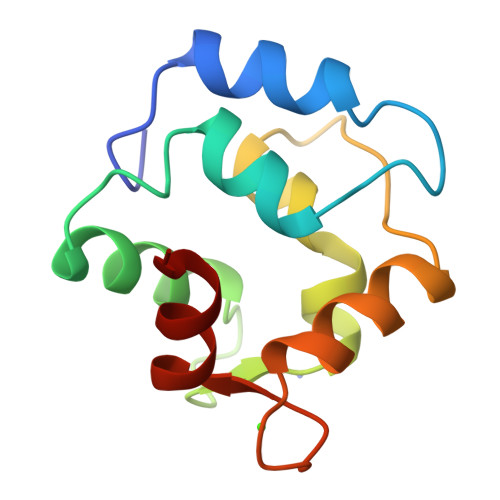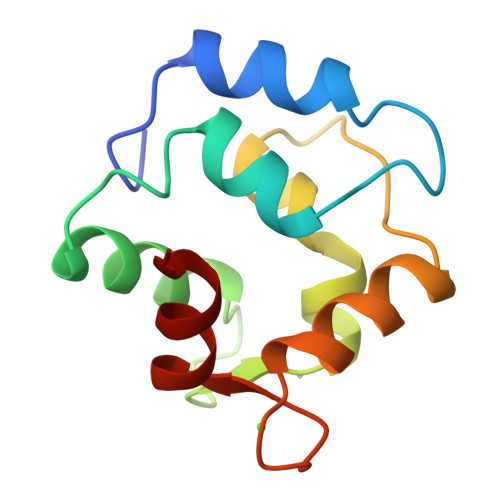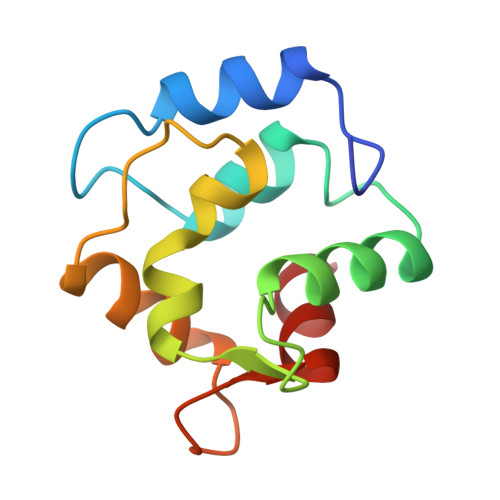Ionic interactions with parvalbumins. Crystal structure determination of pike 4.10 parvalbumin in four different ionic environments.
Declercq, J.P., Tinant, B., Parello, J., Rambaud, J.(1991) J Mol Biology 220: 1017-1039
- PubMed: 1880797
- DOI: https://doi.org/10.1016/0022-2836(91)90369-h
- Primary Citation of Related Structures:
1PAL, 2PAL, 3PAL, 4PAL - PubMed Abstract:
The crystal structure of the Ca-loaded form of pike 4.10 parvalbumin (minor component from pike muscle belonging to the beta phylogenetic series), with both its primary sites CD and EF occupied by Ca2+ ions and its third site occupied by an ammonium ion, as previously determined at 1.93 A resolution, has now been refined to a resolution of 1.65 A. The crystallization of this parvalbumin in different ionic environments has allowed three novel non-isomorphous crystalline forms to be obtained: (1) a first form, crystallized in the presence of a mixture of ammonium sulphate and manganese sulphate, for which all the cation binding sites in the protein are occupied by Mn2+; (2) a second form crystallized in the presence of MgSO4 as the precipitating agent, only differs from the Ca/NH4 form by the occupation of the third site by Mg2+, whereas the primary sites remain occupied by Ca2+; (3) a third form, also crystallized in the presence of MgSO4, corresponds to a well-defined molecular species with both the primary EF site and the third site occupied by Mg2+, whereas the primary CD site remains occupied by CA2+. The corresponding molecular structures reported here have been determined at resolutions between 1.8 and 2.4 A. The comparison of the different crystal structures allows the structural modifications accompanying the substitution of the primary sites by cations differing significantly in their ionic radii (Ca2+, Mn2+, Mg2+) to be investigated in detail, and it also leads to a precise description of the third site in a typical beta parvalbumin. The substitution Ca2+ by Mg2+ within the primary site EF is characterized by a "contraction" of the co-ordination sphere, with a decrease of the mean oxygen-metal distance by a value of 0.25 A and a decrease of the co-ordination number from 7 to 6, as a consequence of the loss of a bidentate ligand (Glu101), which becomes a monodentate one. Such an adaptation of the co-ordination sphere around a cation of smaller size involves, among others, the transformation of the Glu101 side-chain from the stable gauche(+) form to the less stable gauche(-) form. The third site is clearly described as a satellite of the CD primary site, since both sites possess common protein ligands, such as Asp53 and Glu59. Furthermore, Asp61 appears as a specific ligand of the third site in the different environments investigated in this work. We finally discuss the relevance of the third site to parvalbumin phylogeny.
Organizational Affiliation:
Laboratoire de Chimie-Physique et de Cristallographie, Université Catholique de Louvain, Louvain-la-Neuve, Belgium.




















